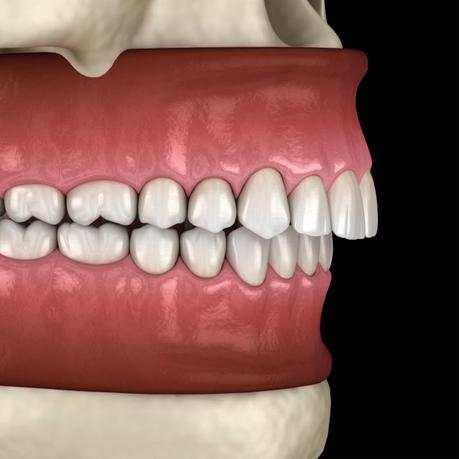
This article will tell you how orthodontists fix deep fights with braces. We’ll go over three ways we fix deep bites, so today, we’re discussing deep bites. Most people may know that braces can fix deep bites, but most have no idea how it all works
before we start talking about how to fix a deep bite, let’s first define what an overbite is. An overbite, sometimes a deep overbite, refers to the top teeth excessively overlapping the bottom teeth this picture is a good example. You may be wondering what excessively overlapping means. Well, generally speaking, an ideal
overbite is when the top teeth overlap the bottom teeth by about two millimetres, so this image here is an excellent example of what we would consider an ideal overbite anytime a bite overlaps by more than
two millimetres orthodontists consider that to be a deep bite or a deep overbite. You may be curious why orthodontists consider a deep bite such a problem because it may not seem obvious to people that the teeth overlap.
There are many ways a deep bite or deep overbite can be fixed, but we’ll discuss three methods we use when correcting deep bites for our patients.
The cosmetic look of an overbite is not concerning us, the real problem is what damage a deep bite can do to your teeth in the long term. As you know, if you have a deep bite, you will put excessive wear and tear on the front teeth over time. This can lead to damage chipping and the need for expensive restorative dental treatments down the road. An overbite is a typical bite that orthodontists fix, and how we fix the overbite will depend on how severe the deep bite is.
What causes a deep bite?
The most common is a small lower jaw. When the lower jaw is shorter than the upper, the upper teeth are further “forward,” and the lower teeth continue to grow until they hit the back of the upper teeth (the cingulate) or the roof of the mouth. Additionally, as the lower front teeth grow up under the top ones, they often get squeezed together, creating crowding and alignment issues.
Another cause of a deep bite is a missing lower tooth. This creates a condition similar to having a short lower jaw. Finally, powerful biting muscles can deepen the bite, which is common in patients who clench or grind their teeth.
Please call Copperhills Family Dentistry at 905-235-2222 for Free Consultations!
How Do We Correct Mild Deep Bites?
The first type of overbite we’ll discuss is a mild deep bite.
The patient’s top teeth overlap the bottom teeth, but they
aren’t too bad overall. You can imagine that if we were to put braces on his top and bottom teeth, he would tend to bite on top of the lower braces due to his deep bite, so to correct this type of deep bite during the braces process, the combination of braces and bite pads would need to be used.
Bite pads are small dental composite pads placed on the top of the teeth to prop the bite open and allow the safe and stable placement of braces. Often these bite pads will be blue to make it easy to remove once braces are completed. By placing bite-pads, the patient will no longer need to worry about biting on the top of the lower braces. A small amount also separates the back teeth, and over time these teeth will gradually drift together, so placing bite-pads on the front teeth and allowing the back teeth to drip together; is usually all that you need to correct a mild deep bite; these bite pads will typically be placed at the same time as braces and will be removed later on into the treatment once the bite is corrected.
QUALITY AFFORDABLE DENTAL IMPLANTS
Copperhills Family Dentistry specialists provide specialized dental services that help our patients cultivate healthy and happy smiles. We’re happy to provide compassionate care coupled with cutting-edge technology.
dental implants TeethWhitening cosmetic
dentistry dental cleaning
and checkups
What Is a Moderate Deep Bite, And How Do We Correct It?
The second type of deep bite we will discuss is a moderate overbite. The top teeth overlap the bottom teeth by a considerable degree and much more than our last example for correcting moderate overbites, we’ll usually use bite pads to separate the back teeth, similar to what we used in the mild overbite correction, but in this case, we’ll also use elastics to help pull the back teeth together.
The back teeth will not touch when the bite pad is in position, and to help these back teeth come together quicker, we’ll ask the patient to attach a rubber band from the top teeth to the lower teeth in the back. This helps to pull these teeth down and to correct the deep bite. Additionally, if a patient has a more severe overbite, a bite turbo may be placed instead of a bite pad. Bite turbos are similar to bite pads but are usually placed on the front teeth instead. We use bike turbos made of transparent dental composite, like bite-pads, so they’re less noticeable. Bite turbos can be combined with rubber bands to help correct more moderate or severe deep bites.
How Is A Severe Deep Bite Corrected?
The third type of deep bite we’ll discuss is a severe overbite: the top teeth overlap the lower teeth entirely. Additionally, the top teeth are biting on top of the lower gums, and the lower teeth are biting into the roof of the palate, so aesthetically this doesn’t look good. Still, functionally, this can cause severe damage to the gum and palatal tissue as well as damaging the teeth. After enough time to correct severe deep bites, we’ll usually begin with braces, bite pads or bite turbos and rubber bands similar to the moderate deep bite correction. This protocol will get us far into the process of overbite correction. Still, if it’s determined we need more bite correction, we may add a focus appliance to help correct the deep bite forces springs work. The forces springs push the lower teeth forward and down and push the top teeth back and up, thereby correcting the deep bite. We discussed just three examples of how deep bites are fixed.
There are many different methods and appliances, and the only way to know for sure which would be best for you or your child is to have a consultation with an orthodontist.

